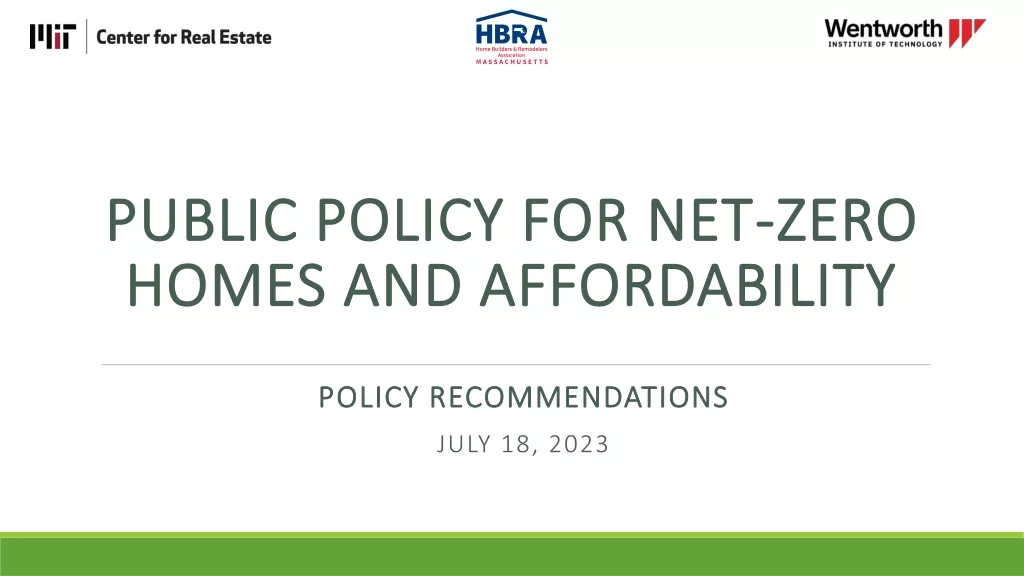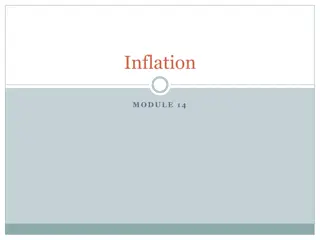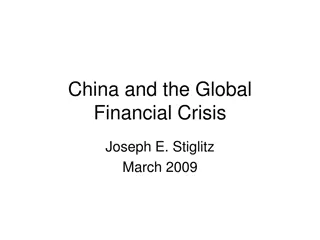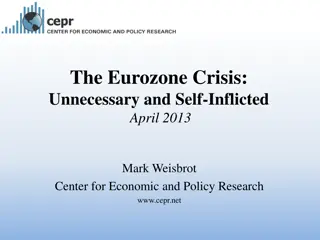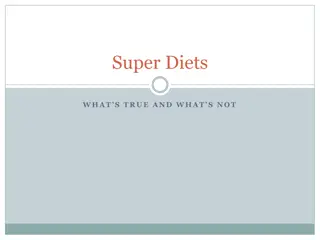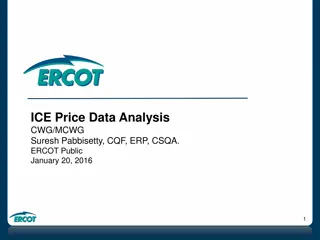Addressing the Global Food Crisis: Insights on Food Prices, Diet Costs, and Affordability
The ongoing global food crisis is severe, as indicated by the rise in retail food prices worldwide. Various organizations are now focusing on using food prices to target social assistance and improve food security. Monitoring nutrition security through the affordability of healthy diets has become a crucial measure. By analyzing least-cost locally available foods, countries can address malnutrition causes and take appropriate action to ensure better access to nutritious foods for all. Visit the provided project site for more detailed information.
Download Presentation

Please find below an Image/Link to download the presentation.
The content on the website is provided AS IS for your information and personal use only. It may not be sold, licensed, or shared on other websites without obtaining consent from the author. Download presentation by click this link. If you encounter any issues during the download, it is possible that the publisher has removed the file from their server.
E N D
Presentation Transcript
Food prices, diet costs and the affordability crisis: Needs and opportunities for social protection William Masters Professor of Food Economics and Policy, Friedman School of Nutrition and Department of Economics, Tufts University Project site: https://sites.tufts.edu/foodpricesfornutrition USP2030 webinar on Addressing the Global Food, Energy and Cost of Living Crises, 6 Apr 2023
The ongoing world food crisis is as bad as previous spikes in the cost of food Average rise in retail food prices relative to all goods and services over previous 12 months worldwide, Jan. 2000 - Dec 2022 2022-23 (recovery from COVID) 6 Recent world food crises: 2008-09 Annualized percent change in real food prices (12-month moving average, times 12) 2020-21 (onset of COVID) Food and non-food inflation is now easing in most countries, but real costs remain high 4 2011-12 2 0 -2 Note: Author's calculations, from IMF data. The values shown are the global average for up to 138 countries reporting monthly consumer price indexes (CPI) for food and for all goods and services, from January 200 through December 2022. Each observation is the average monthly rise over the previous 12 months, multiplied by 12 to obtain an annualized value. Number of countries rises from 51 in Jan 2000 to 95 in 2005 and then 138 from 2015 onwards.
Food prices can now be used for targeting of social assistance and guiding food system change Food security was initially seen in terms of calories for survival Since the 1960s, the FAO has used its Prevalence of Undernourishment metric for the number of hungry people in the world, based on total food consumption relative to target levels of dietary energy Food security was later seen in terms of access to desired foods More recently, the FAO and others use Experience of Food Insecurity scores for the number of people who went to bed hungry, skipped meals, ate less or fewer items, due to lack of money to buy their usual foods Now we can monitor nutrition security, as affordability of healthy diets Since 2020, the FAO, IFAD, UNICEF, WFP and WHO flagship annual reports on the State of Food Security and Nutrition in the World (SOFI 2020, 2021 and 2022) use retail prices of the least-cost locally available foods for a balanced diet that would meet dietary guidelines in each country of the world Methods and results are at https://WorldBank.org/FoodPricesforNutrition, and on FAOSTAT Using least-cost locally available foods to track affordability of a healthy diet provides a diagnosis to distinguish between causes of malnutrition, guiding action in each country Where and when foods are unusually expensive, need better farm production and food distribution to lower prices For people with insufficient income, need higher earnings or assistance
Policies and programs pursue what is measured Since 2020, the FAO has published the cost of each country s least expensive foods needed for health -- a first step up from calories is vitamins & minerals, like the WFP s Fill the Nutrient Gap programs in humanitarian settings -- the next step up meets food group targets to meet nutrient needs and also avoid hypertension, diabetes etc., as specified in national dietary guidelines For SOFI 2020, we used ten countries national dietary guidelines for an average Cost of Recommended Diets (CoRD) By 2020, global average minimum cost of a healthy diet had risen to $3.54 (SOFI 2023 will update this) Food preferences, convenience and other goals (including food security, diet diversity, sustainability, equity and inclusion) Actual food spending was $5.64 Healthy diets Meets national dietary guidelines by food group Global average cost in 2017: $3.31 For SOFI 2022, we developed a single global Healthy Diet Basket of 11 items in 6 food groups for a simpler Cost of a Healthy Diet (CoHD) Nutrient adequacy Avoids deficiency or excess of essential macro- and micronutrients $2.46 $0.83 Daily energy Caloric adequacy (short-term subsistence) Meets only calorie needs, for short-term survival and physical work Source: Food Prices for Nutrition (2022). https://sites.tufts.edu/foodpricesfornutrition
What foods are included in a least-cost healthy diet? Foods selected are the least expensive items being sold at the time and place of measurement Pulses, nuts or seeds (1 x 300 kcal) Animal-source foods (2 items x 150 kcal each) Edible oil (1 x 300 kcal) $3.02/day $3.44/day $2.29/day Vegetables (3 at 30 kcal each) Starchy staples (2 at 580 kcal each) Fruits (2 at 80 kcal each) Note: Data shown are each food group s share of cost per day using ICP 2017 items and prices. Source: Food Prices for Nutrition (2022). https://sites.tufts.edu/foodpricesfornutrition
What have we discovered about the cost and affordability of healthy diets? Cost of the least expensive items for a healthy diet in 2017 7 Food costs differ but are not lower in low-income countries when measured in real terms, compared to other goods & services Least-cost healthy diets are unaffordable for the very poor, about 3 billion people 6 Based on overall food price inflation relative to incomes, real costs rose to $3.54 in 2020, higher in 2021 and 2022 Cost per day at PPP prices in 2017 5 Global average costs in 2017 4 Cost of a healthy diet [CoHD] $3.31 (meets dietary guidelines for overall health) 3 $2.46 (within upper & lower bounds for nutrients) Cost of a nutrient adequate diet [CoNA] 2 1 $0.83 (sufficient calories for work each day) Cost of an energy sufficient diet [CoCA] 0 500 5,000 50,000 GNI per capita at PPP prices in 2017 dollars (log scale) Diet cost data are from FAO and the Food Prices for Nutrition project, using item prices reported by national statistical organizations through the International Comparison Program (ICP), downloaded from https://databank.worldbank.org/source/food-prices-for-nutrition, and national income (GNI) is from the World Development Indicators https://databank.worldbank.org/source/world-development-indicators. Guidelines are linear in the logarithm of income shown on the horizontal axis.
How does actual spending on food compare to the cost of healthy diets? Cost of the least expensive items for a healthy diet and actual food expenditure in 2017 14 Average food spending is much greater than least-cost healthy diets in middle- and high-income countries but that is the national average, many households in these countries cannot afford healthy diets, especially now. 13 12 Cost per day at PPP prices in 2017 11 10 9 Global average costs in 2017 8 $5.64 (pursues many goals other than health) $3.31 (meets dietary guidelines for overall health) Food expenditures (FoodExp) 7 Actual food spending is less than healthy diet costs in low-income countries 6 Cost of a healthy diet [CoHD] 5 4 3 $2.46 (within upper & lower bounds for nutrients) Cost of a nutrient adequate diet [CoNA] 2 1 Cost of an energy sufficient diet [CoCA] $0.83 (sufficient calories for work each day) 0 500 5,000 50,000 GNI per capita at PPP prices in 2017 dollars (log scale) Diet cost data are from FAO and the Food Prices for Nutrition project, using item prices reported by national statistical organizations through the International Comparison Program (ICP), downloaded from https://databank.worldbank.org/source/food-prices-for-nutrition. Food expenditures are derived from those data, and national income (GNI) is from the World Development Indicators https://databank.worldbank.org/source/world-development-indicators. Guidelines are linear in the logarithm of income shown on the horizontal axis.
How does affordability of healthy diets relate to food insecurity? Affordability of healthy diets and prevalence of food insecurity in 2017 Here, food insecurity is a person s answers to whether they ate less, skipped meals, went hungry etc. for lack of money to buy food Unaffordability is much more prevalent than food insecurity in LMICs Food insecurity measures access to a person s usual foods, which are similar from week to week so what it measures is financial precarity 100 90 Percent of the population in 2017 80 70 60 50 Proportion of the population who cannot afford a healthy diet (%) 40 30 20 Prevalence of moderate or severe food insecurity in the population (%) 10 0 500 5,000 50,000 GNI per capita at PPP prices in 2017 dollars (log scale) Data shown are FAO estimates, downloaded from https://databank.worldbank.org/source/food-prices-for-nutrition for affordability of healthy diets, and from https://databank.worldbank.org/source/world-development-indicators for experience of food insecurity and national income (GNI).
Diet costs could be used for targeting and adequacy of social assistance Food spending per person per day (in local currency or US$ at PPP exchange rates) Observed expenditure or income available for food Example assistance program targeted to the lowest-income 25% of people, at an adequacy level sufficient for some to afford a healthy diet Min. cost of healthy diets (typically 6-8 food groups) Min. cost of nutrient adequacy (typically 4-5 food groups) Min. cost of caloric adequacy (from starchy staples only) Targeting and coverage could be based on needs to reach nutritional standards for health 0 0 25 100 Cumulative share of the population Source: Adapted from graphic introduced by Saskia de Pee (WFP).
https://sites.tufts.edu/foodpricesfornutrition Thank you! We thank the many price collectors and contributors to the diverse databases used in this work and are grateful for funding to the Bill & Melinda Gates Foundation and UKAid, as well as complementary funding from FAO. Photo by Anna Herforth at Agbogbloshi market, Ghana


![READ [PDF] Dash diet Cookbook for beginners: 365 days of simple, healthy, low-s](/thumb/2057/read-pdf-dash-diet-cookbook-for-beginners-365-days-of-simple-healthy-low-s.jpg)

